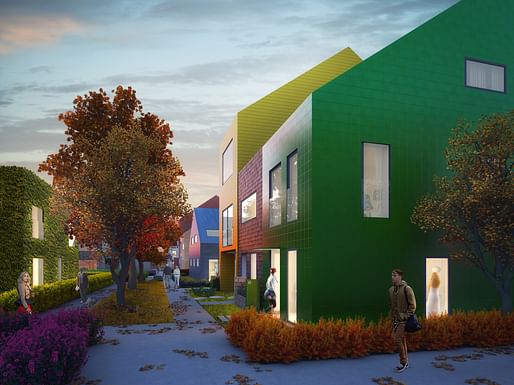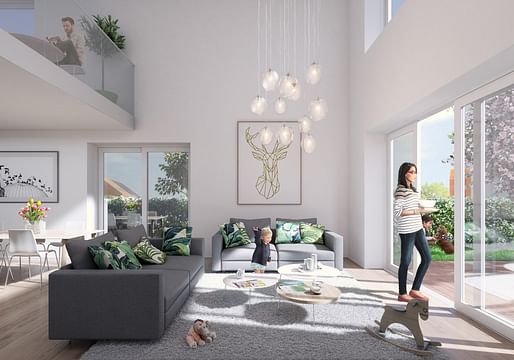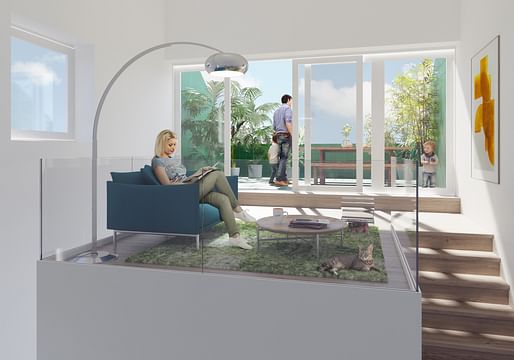
MVRDV has broken ground on their Traumhaus Funari project in Mannheim, Germany, transforming a former U.S. military barracks into a suburban residential neighborhood. The design for the new neighborhood is shaped by a series of options and rules, intended to promote diversity in the streetscape by allowing residents to make meaningful choices about their homes.

Funari is one of five districts forming the redevelopment of Mannheim’s Franklin quarter, which once housed a U.S. military base. For the scheme’s development, MVRDV partnered with prefabricated housing developer Traumhaus, who specializes in housing created from mass-produced, standardized elements. For Funari, MVRDV adapted this standardized approach to create a catalog of housing typologies, allowing residents to choose from variations in materials, sizes, interior layouts, and connections to external space.

“Traumhaus has already shown how a systematic construction approach can increase affordability and accessibility in housing”, says MVRDV founding partner Winy Maas. “With Traumhaus Funari we want to take the next step, creating a model that retains this affordability while challenging the expectations for lifestyle, and the and variety of ways to inhabit, a suburb or village. In Funari we are creating something that is more sustainable and more social — a model that can be replicated across Germany and beyond, to the benefit of everyone. From Traumhaus to traum world.”

The catalog created by the design team is organized into two broad sections. The “Traumhaus 1.0” series consists of the original Traumhaus product, which can be developed with choices in material (1.1) and floor area (1.2). The “Traumhaus 2.0” series features more bold, individual variations, including stilt houses and colorful printed facades.

The first phase of the master plan will provide 124 single-family homes and 26 apartments. The variety within the catalog is intended to broaden the appeal of the development to different demographics and family units.
“Houses with green façades appeal to the budding eco-family, and bright colors and patterns are on offer for people with highly individual tastes,” the team explains, “while more traditional materials such as wood may suit those who are more reserved.” While a range of stilt houses open up the ground floor plots to favor outdoor lifestyles, a range of single-story homes is designed for elderly residents. Among the individual dwellings, two larger apartment blocks are aimed to suit the needs of students, short-term residents, or residents with accessibility needs.

The Funari site is surrounded by a parkland linking into a network of footpaths across the neighborhood. In order to create more pedestrian-friendly streets, car parking is restricted to an underground level, allowing for surface-level open spaces such as sports parks, fruit alleys, butterfly gardens, and private residential gardens. To complement the scheme’s colorful facades, a landscape strategy incorporates plant species selected for their bright, vibrant flowers.

News of the scheme comes one month after MVRDV released details of their design for an R&D headquarters in Shanghai with layered terraces. The firm has also recently unveiled plans for a visitor center at Rotterdam Port and a “Music Mountain” in Eindhoven.
4 Comments
Reminds me of Katrina housing with details that ignore weather and performance. I'm guessing 'traumahouse' refers to future maintainence.
This is something with potential as a masterplan, but the flashitecture is a distraction really.
What do you base that on, Miles?
It's pretty close to the idea of their project in Ypenburg, in the Hague. A relatively straightforward construction and plan, all things considered. Seems like this new project will be much the same. I find it a nicer version of typical Dutch planning - quiet, introverted buildings that create something like a shared space between them, but not much hustle bustle or mixing of uses. Basically a nice suburb, with some visual variety. If there is anything to critique I suppose it could be whether it is a good model to make these car-oriented developments still. Parking is set on the perimeter so the block itself is quite nice to be in, but beyond that its a lot like the new urbanist projects in the USA, functioning as an enclave but still working in the same capitalist system, and so the impact is only lcoal. They recognize that problem and see this as something that can happen inside those constraints. Taking it on those terms it is a remarkable plan, with a lot more shared outdoor space than the developments around it. Their plan creates a lot of depth and places to wander and play that I think are quite an achievement. To do more will require changes in government and economics. If we are generous it is not unreasonable to see this as a nudge towards that end...
Aside from the details that ignore weather and performance such as lack of overhangs, window and door protection, roof drainage; zero-edge conditions, etc?
Block this user
Are you sure you want to block this user and hide all related comments throughout the site?
Archinect
This is your first comment on Archinect. Your comment will be visible once approved.